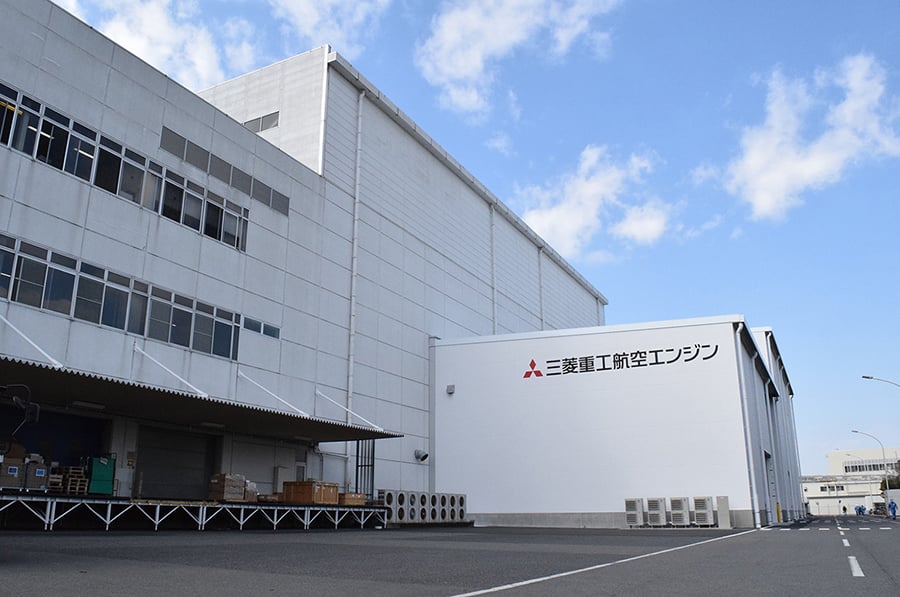Aerospace
Mitsubishi converted the MRJ production facility into a maintenance hangar after the programme was terminated.

Tokyo, March 7, 2023 – Mitsubishi Heavy Industries Aero Engines, Ltd. (MHIAEL), a group company of Mitsubishi Heavy Industries, Ltd. (MHI), has completed expansion work at its aero engine maintenance shop in Komaki City, Aichi Prefecture, to respond to globally expanding demand for maintenance, repair and overhaul (MRO) services. The expanded facility is expected to increase its commercial engine MRO capacity from 5 to 6 units per month to more than 10 units per month by 2026, then ultimately reaching 15 units per month.
The expansion work added floor area of 2,500m² in addition to the pre-existing floor area of approximately 11,600m², resulting in 20% increase of the workspace.In addition to the ongoing MRO business for PW4000 and V2500 engine models respectively powering Boeing B747 and Airbus A320 aircraft, the expanded shop will also perform MRO for the best-selling state-of-the-art PW1100G-JM powering the Airbus A320neo family aircrafts.
The facility expansion also introduces a highly efficient layout to the shop floor.The pre-existing area is now dedicated to all manually performed processes (engine disassembly, assembly, inspection, etc.), while the newly added workspace is used for the large-scale equipment for balancing, grinding, etc., as well as parts kitting process.The facility is expected to achieve capacity of 15 units per month in this new, optimized shop floor.
MHIAEL’s history of aero engine MRO business dates back to 1993 when it started services for PW4000 engine and its modules.To date, MHIAEL accumulates experience to provide service for more than 900 units.Given the incremental increase of production rate of Airbus A320neo family, it is anticipated that number of PW1100G-JM and the MRO demands associated thereto will be doubled in next few years.
Mitsubishi Announced The Discontinuation Of SpaceJet program(Opens in a new browser tab)
MHIAEL ensures to deliver high-quality products for the increasing demands through its robust systems to manage quality and workforce.Adding to those systems, MHIAEL works on MRO technology development as well as introducing Smart Factory.Also, besides the MRO business, MHIAEL continues business of aero engine components manufacturing expanding its capability at two manufacturing facilities in Komaki and Nagasaki.
MHI Group, in anticipation of increased demand for commercial aero engines worldwide through the long term, is expanding its related business and production structures, and expansion of MHIAEL’s Komaki facility is part of this initiative. Going forward, MHI will work in close cooperation with MHIAEL to enhance its technological capabilities and reliability in aero engine development, manufacture and after-sales servicing, to contribute to the advancement of Japan’s aircraft industry.

Aerospace
Boeing Transfers Rocket Stage to NASA, Paving Way for Human Moon Mission

Boeing has achieved a significant milestone by providing NASA with the second core stage of the Space Launch System (SLS) rocket.
This crucial component, crafted at NASA’s Michoud Assembly Facility (MAF), is set to propel the Artemis II crew into lunar orbit, marking humanity’s return to deep space after a 50-year hiatus.
The monumental Boeing-built rocket stage, the largest element of the Artemis II mission, will embark on a journey aboard the Pegasus barge, traveling 900 miles to NASA’s Kennedy Space Center.
Comparison of two legendary aircraft B777x vs B747 aircraft:Click here
Upon arrival, it will be meticulously integrated with other essential Artemis II components, including the upper stage, solid rocket boosters, and NASA’s Orion spacecraft within the iconic Vehicle Assembly Building. This intricate integration process is a vital step toward the eagerly anticipated Artemis II launch, slated for 2025.
“Boeing-built products helped land humankind on the moon in 1969, and we’re proud to continue that legacy through the Artemis generation,” remarked Dave Dutcher, vice president and program manager for Boeing’s SLS program. “Together, with NASA and our industry partners and suppliers, we are building the world’s most capable rocket and paving the way to deep space through America’s rocket factory in New Orleans.”
NASA, Lockheed Martin Reveal X-59 Quiet Supersonic Aircraft:Click here
The delivery of Core Stage 2 marks a significant achievement in the evolution of the SLS rocket. Towering over 200 feet and powered by four RS-25 engines, this core stage, coupled with two solid-fueled booster rockets, will generate a staggering 8.8 million pounds of thrust. This immense power is crucial to launching Artemis II and future missions into the vast expanse of space.
The SLS rocket stands unparalleled in its capability to transport both crew and substantial cargo to the moon and beyond in a single launch. Its extraordinary capacity will facilitate the delivery of human-rated spacecraft, habitats, and scientific missions to destinations including the moon and Mars, ushering in a new era of space exploration.
-

 Travel1 week ago
Travel1 week agoAir India to Expand US Operations with Three New Routes After a Decade
-

 Travel2 weeks ago
Travel2 weeks agoWhy We Should Avoid These Stamps in a Passport
-

 Airlines1 month ago
Airlines1 month agoInvestigations Reveal Fake Chinese Titanium in Boeing and Airbus Jets
-

 Tech4 weeks ago
Tech4 weeks agoChina’s CATL Plans 1,800-Mile Electric Plane Launch by 2027
-

 Airport3 days ago
Airport3 days agoTop 10 Largest Airports in the World by Size
-

 Aerospace4 weeks ago
Aerospace4 weeks agoChina’s Fighter Jets Turn Wings into Autonomous Drones
-

 Airlines4 days ago
Airlines4 days agoAir India Rolls Out A350s for Delhi-New York JFK and Newark Routes
-

 Defence3 weeks ago
Defence3 weeks agoBoeing Enhances Chinook with New Engines and Block II Upgrades at $96 Million







